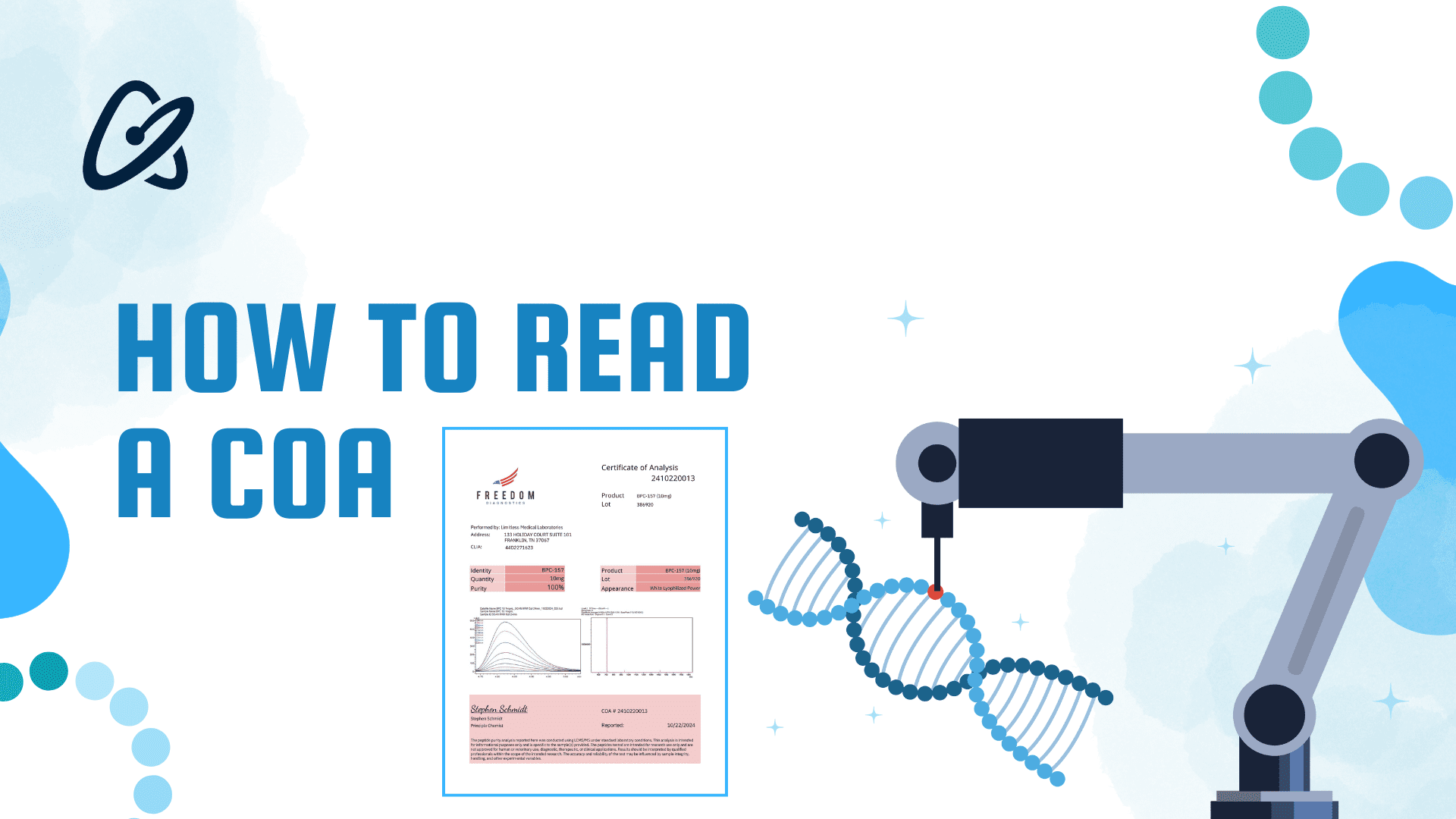How To Read a COA: A Guide for Research Peptides

When you buy research peptides, making sure they are high quality is crucial for successful experiments. A Certificate of Analysis (COA) is a reliable tool to confirm a product’s authenticity, purity, and peptide content. At Atomix Research, we focus on transparency by providing detailed COAs with every peptide batch. This guide explains what a COA is, what it includes, how to read it, and how to understand it, with an emphasis on purity, identification analysis, and peptide content, to empower you as a customer.
What is a Certificate of Analysis (COA)?
A Certificate of Analysis (COA) is an official document from a laboratory that confirms the quality, composition, purity, and peptide content of research peptides. It acts as a quality assurance certificate, ensuring the product meets strict standards before you receive it. At Atomix Research, every COA is prepared by an independent lab, giving peace of mind to researchers and buyers. Without a COA, you risk using contaminated or wrongly labeled compounds, which can disrupt your research results.
What Does a COA Contain?
A COA is a detailed report with important sections designed to inform you about your purchase:
– Product Information: Includes the peptide name, batch number, and manufacturing details.
– Test Specifications: Outlines expected standards, such as purity and peptide content thresholds.
– Analytical Methods: Describes techniques like High-Performance Liquid Chromatography (HPLC) or Mass Spectrometry (MS) used for testing.
– Results: Presents data, including percentages and graphs, to confirm quality.
– Certification: Features a signature from a qualified professional and the report date. These sections help you assess whether the peptide suits your research needs, making the COA an essential resource.
How to Read a COA:
Step-by-Step Process Reading a COA can seem complicated, but breaking it down makes it easier.
Follow these steps:
1. Verify Details: Confirm the peptide name and batch number match your order. Check the issuance date to ensure it’s recent.
2. Identify Test Methods: Look for HPLC (for purity) or MS (for identity) to understand how results were obtained.
3. Review Results: Compare test outcomes to specified standards and look for pass/fail indicators.
4. Analyze Visual Data: Interpret charts or spectra that provide a visual confirmation of quality.
5. Check Authenticity: Ensure the document is signed by a certified expert and includes lab credentials. This systematic approach helps you confidently evaluate the COA, ensuring you’re using a reliable product.
How to Understand a COA: Focus on Purity, Identification Analysis, and Peptide Content
To fully understand a COA, focus on three key areas: purity, identification analysis, and peptide content. These metrics determine the peptide’s quality, authenticity, and concentration.
Purity Analysis
Purity indicates the percentage of the desired compound compared to impurities. Measured using HPLC, a high purity level (usually over 98%) is essential for accurate research. The COA will list a percentage, so aim for values close to 100% to reduce contamination risks. A clean HPLC chromatogram with a single peak shows high purity. Low purity could compromise your experiment’s validity, so always prioritize this data.
Identification Analysis
Identification confirms the peptide is the correct compound. This is done through Mass Spectrometry (MS), which matches the peptide’s molecular weight to its theoretical value, usually within ±0.1%. This step prevents the use of mislabeled or counterfeit products. Understanding this ensures your research matches the intended peptide sequence, improving result reliability.
Peptide Content
Peptide content measures the actual amount of peptide in the product, typically shown as a percentage of the total weight or concentration (e.g., mg/mL). This is important to ensure you receive the expected quantity for your experiments. The COA may include quantitative assays or UV spectroscopy data to verify peptide content against the labeled amount (e.g., 10mg). Any discrepancies could indicate improper formulation or degradation, so be sure it matches the product specification to avoid under-dosing or over-dosing in your research.
Practical Tips for Customers
– Compare Standards: Ensure purity is over 98% and peptide content matches the labeled quantity.
– Seek Clarification: Contact Atomix Research if any part of the COA is unclear; we’re here to help.
– Store Safely: Keep your COA for future reference or audits.
– Spot Red Flags: Question results if purity, identification, or peptide content data is missing or seems inconsistent. These tips help you effectively use the COA, maximizing your research investment.
Why Trust Atomix Research for Your Peptide Needs?
At Atomix Research, we provide COAs with every peptide purchase, ensuring transparency and quality. Our commitment to excellence makes us a top choice for researchers. Visit AtomixResearch.com to explore our peptide range and read more about peptide science on our blog. If you have questions, our team is ready to assist!
